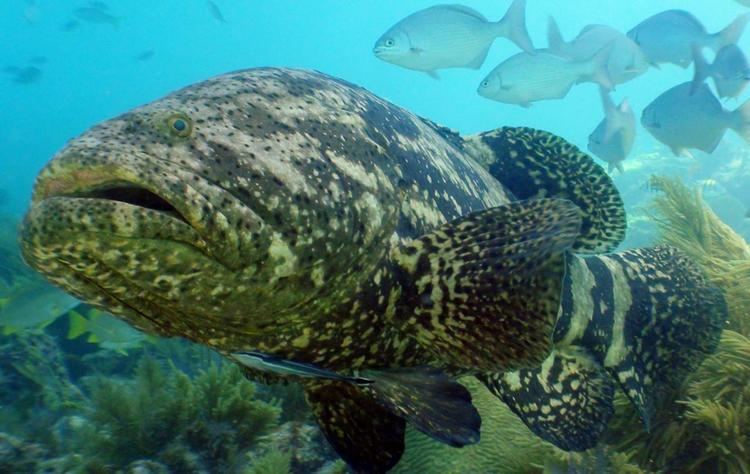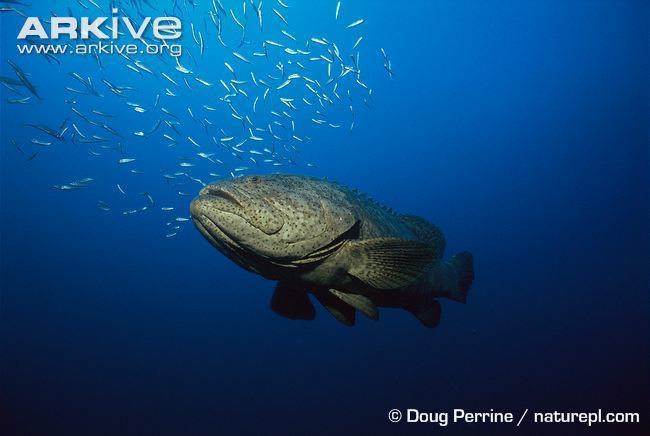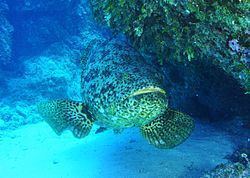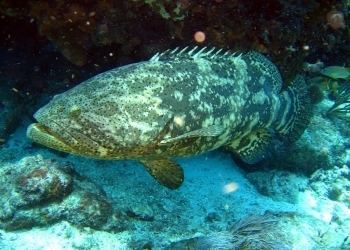Rank Species | Phylum Chordata Scientific name Epinephelus itajara Higher classification Epinephelus | |
 | ||
Similar Grouper, Giant grouper, Epinephelus, Black grouper, Red grouper | ||
The Atlantic goliath grouper or itajara (Epinephelus itajara), also known as "Jew fish" is a large saltwater fish of the grouper family found primarily in shallow tropical waters among coral and artificial reefs at depths from 5 to 50 m (16 to 164 ft). Its range includes the Florida Keys in the US, the Bahamas, most of the Caribbean and most of the Brazilian coast. On some occasions, it is caught off the coasts of the US states of New England off Maine and Massachusetts. In the eastern Atlantic Ocean, it occurs from the Congo to Senegal.
Contents

Description

Young Atlantic goliath grouper may live in brackish estuaries, oyster beds, canals, and mangrove swamps, which is unusual behavior among groupers.

They may reach extremely large sizes, growing to lengths up to 2.5 m (8.2 ft) and can weigh as much as 360 kg (790 lb). The world record for a hook-and-line-captured specimen is 308.44 kg (680.0 lb), caught off Fernandina Beach, Florida, in 1961. They are usually around 180 kg (400 lb) when mature. Considered of fine food quality, Atlantic goliath grouper were a highly sought-after quarry for fishermen. The grouper's inquisitive and generally fearless nature makes it a relatively easy prey for spear fishermen. They also tend to spawn in large aggregations, returning like clockwork to the same locations, making them particularly vulnerable to mass harvesting.
Until a harvest ban was placed on the species, its population was in rapid decline. The fish is entirely protected from harvest and is recognized as a critically endangered species by the IUCN. The US began protection in 1990, and the Caribbean in 1993. The species' population has been recovering since the ban; with the fish's slow growth rate, however, some time will be needed for populations to return to their previous levels.
Goliath grouper eat crustaceans, other fish, octopodes, young sea turtles, sharks, and barracudas. They are known to attack divers, and have even been seen attacking large lemon sharks.
Reproduction
Goliath groupers are believed to be protogynous hermaphrodites, which refer to organisms that are born female and at some point in their lifespans change sex to male. Most grouper follow this pattern, but this has not yet been verified for the goliath. Males can be sexually mature at about 115 centimetres (45 in), and ages 4–6 years. Females mature around 125 centimetres (49 in), and about 6–8 years.
Conservation
In May 2015, the Atlantic goliath grouper was successfully bred in captivity for the first time.
Parasites
As with other fish, the Atlantic goliath grouper is the host of several species of parasites, including the diplectanid monogenean Pseudorhabdosynochus americanus on its gills.
Terminology
The Atlantic goliath grouper has been referred to as the jewfish. The name's origin is unclear, and may have referred to the flesh having a "clean" taste comparable to kosher food, been an insulting suggestion that the fish provided low quality meat and was "only fit for Jews", or that the word was simply a corruption of jawfish. In 2001, the American Fisheries Society stopped using the term because of concerns that it was culturally insensitive.
